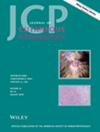Perineuriomatous Melanocytic Nevi: A Case Series of Four Cases
Abstract
Background
Melanocytic tumors with perineuriomatous differentiation may pose diagnostic challenges. This study explores characteristics of perineuriomatous melanocytic nevi, an entity merging features of perineurioma and melanocytic nevi. The aim is to elucidate histopathological features of perineuriomatous nevi to allow dermatopathologists to recognize them and differentiate them from other spindle cell lesions.
Method
This study reviews four cases (2020–2023) of melanocytic nevi with perineuriomatous components.
Results
All cases comprised adults (median age: 64.50, mean age: 60.25), with a female predominance, and exhibited clinical features characterized by irregular brown macules or papules on the trunk and extremities. Histopathologically, all lesions were compound, and biphasic patterns were evident, encompassing superficial nevoid and deeper spindled populations arranged in whorled fascicles and embedded in a sclerotic or myxoid stroma. Immunohistochemistry revealed expression of at least one perineuriomatous marker in deeper cells. Cases were assessed and compared with previously published cases for comprehensive insights. Three of our four cases demonstrated the presence of a junctional component that was smaller than the dermal component. We suggest that this unusual feature, which we term the “reverse shoulder”, may allow dermatopathologists to help consider perineurial differentiation in the appropriate setting.
Conclusion
Perineuriomatous nevi can pose diagnostic challenges. This study contributes to the growing body of literature on perineuriomatous nevi, emphasizing their unique features and the importance of accurate diagnosis to avoid unnecessary interventions.

 求助内容:
求助内容: 应助结果提醒方式:
应助结果提醒方式:


